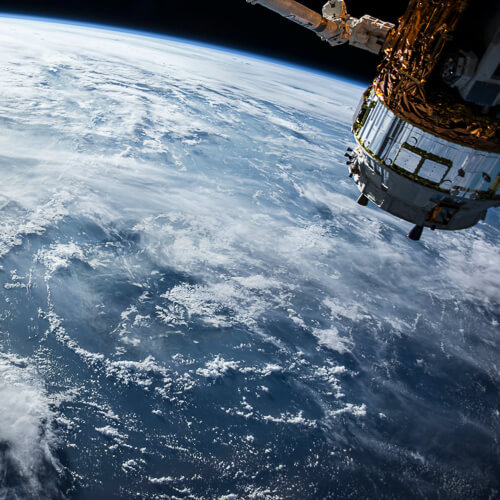
There were 7,941 satellites orbiting Earth as of September 16, 2021, and this number does not seem likely to go anywhere but up, quickly.
More than 1,000 new satellites launched for the first time in 2020, and 2021 has already beaten last year's total with 1,400 launched by mid-September.
From Europe to China to Britain, a frenzied world satellite market seems to be heating up still further this week.
Figure 1:  Spinning in my tin can: Major Tom would have found himself surrounded by satellites if he blasted off today.
Spinning in my tin can: Major Tom would have found himself surrounded by satellites if he blasted off today.
(Source: NASA)
A large space connectivity consortium has formed in Europe. China's Geely has started plonking out satellites. Satellite startups like Isotropic Systems, which lets Internet users hop between satellite broadband networks, are hoovering up investment, as the first listed space tech investment fund gets to work.
If you worried whether the market was frenzied enough, never fear. Two British entrepreneurs have made $1 billion each since launching Arqit Quantum, a satellite cybersecurity company (with negligible current revenues), on the US stock market on September 7.
There's even a cute satellite-servicing robot, announced by Northrop Grumman, which from 2024 will be able to attach jetpacks to the backs of dying satellites, giving them an extra six years of life.
The robot, called the Mission Robotic Vehicle, will eventually be able to perform simple repairs and inspections, too.
The third symphony
Twenty two European space-sector companies have come together to form a consortium working on an EU space-based global secure connectivity system. The consortium, called New Symphonie, is in response to a call for tenders made by the European Commission and its Directorate General for the Defence Industry and Space (DG DEFIS).
The tenders are for up to two contracts of six months' duration, with a maximum value of €1.4 million (US$1.6 million) each.
The leading players in the consortium are Unseenlabs, which currently has a constellation of four satellites in orbit, with a fleet of 25 nanosatellites planned by 2025, and Euroconsult, a consulting firm specializing in satellites.
Unseenlabs, founded in 2015 by two brothers and based in Rennes, in France's Brittany region, has particularly established a name for itself using satellite radio frequency to geolocate ships at sea.
Using technology that identifies the electromagnetic waves which a particular ship emits, it can geolocate vessels from space, in near real time, to within a kilometer. The company completed a €20 million ($23.4 million) fundraising round this April, after a first €7.5 million ($8.8 million) round in 2018.
For Blue Oceans Partners, which invested in the April round, the technology offers "unprecedented and disruptive kind of data which is critical in the fight against illegal fishing, illicit trade and piracy."
It "enables the monitoring of vast marine areas far more efficiently than previously possible," said its co-founder Christian Lim.
The consortium formed in response is called New Symphonie, because there was a previous Symphonie.
Launched in December 1974, as a partnership between France and Germany, the communication satellite was the forerunner for subsequent communication satellite cooperation between the two countries, and later within Europe.
Days later, France's President Valéry Giscard d'Estaing and Germany's Chancellor Helmut Schmidt exchanged their New Year greetings live in a videoconference, via Symphonie-A in geostationary orbit.
It was the first geostationary telecommunications satellite built and operated in Europe. Symphonie B followed in 1975, and the two satellites lasted until 1983 and 1984 respectively.
Chinese satellites for driverless cars
Hangzhou-based carmaker Geely, which is China's largest private automaker, announced today it is now hard at work making commercial satellites at its factory in the eastern city of Taizhou.
"The first set of low-orbit satellites rolled off the production line," the company tweeted this morning.
The Taizhou factory will make 500 satellites a year, all to meet demand for low-orbit, high-speed connectivity to support self-driving and deliver quick software updates to cars.
Automakers are increasingly thinking they cannot wait for a worldwide rollout of 5G to get driverless cars on the road. Satellites may be a better option. Especially given an autonomous vehicle will generate as much as 40 terabytes of data an hour, from onboard cameras, radar and sensors.
The counterargument is latency: It can take 50 milliseconds for a signal to travel from space to a car, while a cellular network can reduce this to ten. While this difference still remains, carmakers will be looking to run deep learning algorithms on the car itself.
The first set of low-orbit satellites rolled off the production line, marking a new milestone in Geely's development in aerospace sector.https://t.co/YvV5AEC0Cl
— Geely Group (@GeelyGroup) September 27, 2021
Also, while GPS provides accuracy to the level of meters, driverless vehicles will need navigation accurate to the centimeter level. Researchers at Ohio State University and the University of California at Irvine this week used signals from six SpaceX satellites to pinpoint locations within eight meters, suggesting it could "provide a promising alternative to GPS."
The Geely constellation, expected to stretch into the thousands of satellites, will not require costly basestations, says the company.
The Chinese company also has developed a partnership with Volvo, while expanding its footprint into trucking, rail and drones.
Space tech investment for network-hopping
The world's first listed space tech fund, Seraphim Space Investment Trust PLC, has made its first investment since its IPO on the London Stock Exchange in July.
Seraphim led a funding round which raised $37 million for UK-based Isotropic Systems, which is developing a new type of broadband terminal that can communicate across multiple frequencies.
This means it can connect to more than one satellite network at a time, without loss in signal quality or network speed. So Isotropic's clients could use one hardware solution to connect to the satellite broadband offerings of OneWeb, SpaceX, Intelsat, SES and Amazon.
Want to know more about satellite? Check out our dedicated satellite content channel here on Light Reading.
If you're using Wi-Fi on an international flight, currently you would encounter weak speed, and frequent drops in coverage. But if your jet was switching between networks as necessary to choose the best possible quality, and maybe even combining available bandwidth to boost speeds, then you might be onto a winner.
Isotropic, based in Reading, is aiming to go into production by 2022. Boeing HorizonX, Space Angels, Orbital Ventures have all invested in rounds so far. SES, the multi-orbit satellite provider, is a big investor, too.
If there's a moral in all of this, it's that satellite investment, especially around connectivity and driverless cars, is going sky high.
Altogether, there was $4.5 billion in private investment in space companies in the second quarter, says New York-based firm Space Capital. Compared with $9.1 billion in all of 2020, this is on track to blast off from the level of the year before.
Related posts:
— Pádraig Belton, contributing editor special to Light Reading
About the Author(s)
You May Also Like











